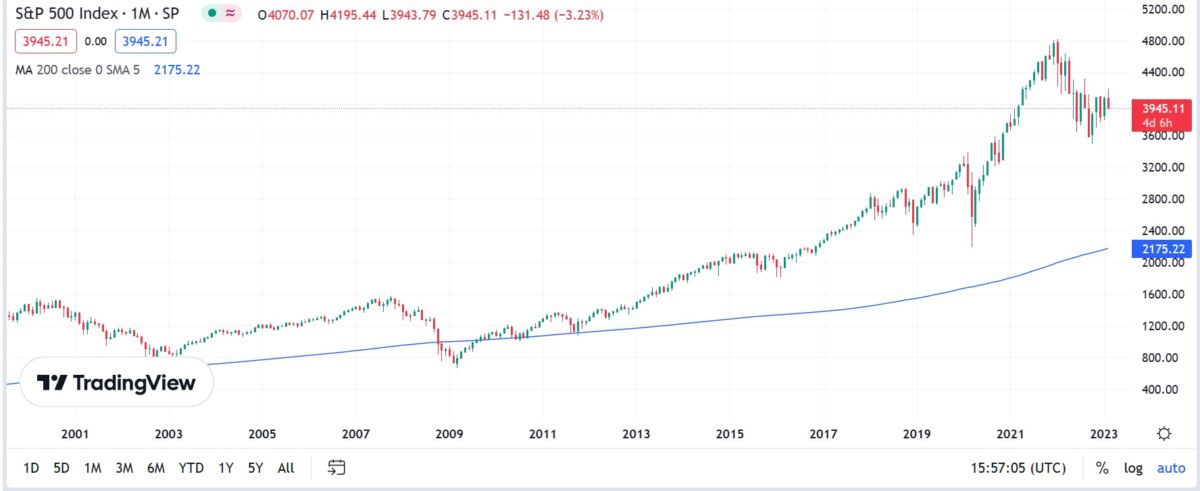Investing in the S&P 500 can be an intelligent and easy way to gain exposure to the US stock market. In this article, we’ll explore why to invest in the S&P 500, the pros and cons of investing in the index, and the main benefits of doing so.
What is the S&P 500 index?
The S&P 500, or Standard & Poor’s 500, is a stock market index that measures the performance of the 500 largest publicly traded companies in the United States. The index is designed to be a benchmark for the overall performance of the US stock market and is often used by investors as a gauge of the economy’s health.
The S&P Dow Jones Indices Committee selects the companies included in the index based on market capitalization, liquidity, and industry sector representation. In addition, the S&P 500 is a capitalization-weighted index, meaning that companies with larger market capitalizations significantly impact the index’s performance.
More to read: How to invest in real estate
As a result, the index is widely used by investors and financial professionals as a benchmark for US equity investments. In addition, it is often tracked by passive index and exchange-traded funds (ETFs).
Passively managed ETFs try to replicate the performance of a market index, such as the S&P 500, similar to index funds. Managers acquire a basket of assets to copy the benchmark index holdings and then sell shares to investors.
You can also read: Investing red flags – how to spot a scam
Here’s how ETFs are different:
The shares issued by an ETF trade like stocks, with fluctuating prices throughout the day. In contrast, index fund shares are only traded once every day, at the closure of the markets. For typical buy-and-hold investors, the distinction is relatively insignificant.
“When you buy the S&P 500, 90% of the time, you’re likely to outperform an active portfolio manager picking large-cap stocks,” says Joe Favorito, managing partner at Landmark Wealth Management.

S&P 500 1M chart, source: tradingview.com
How to invest in the S&P 500 index?
First, create a brokerage account with a reliable business that provides access to the S&P 500 index. Charles Schwab, Fidelity, E-Trade, and TD Ameritrade are examples of well-known internet brokers.
Once an account has been created, it must be funded with investment capital. Afterward, you may transfer funds from your bank account, establish automatic deposits, or deposit a check.
Choose a financial vehicle. Investing in the S&P 500 index is possible through mutual funds, exchange-traded funds (ETFs), and index funds. Each choice has its own benefits and drawbacks, so it is essential to research and select the one that best matches your financial objectives and risk tolerance.
After selecting an investment vehicle, you may execute a trade to purchase shares of the S&P 500 index. First, you can look for the fund’s ticker symbol and place an order through your brokerage account.
After investing, monitoring it and making any required modifications over time is essential. This may necessitate rebalancing your portfolio or modifying your investing strategy in response to market or personal developments.
Pros and cons of investing in the S&P 500
Like any investment, there are pros and cons to investing in the S&P 500. Here are some to consider:
Pros:
- Diversification: As mentioned, investing in the S&P 500 exposes investors to a broad range of companies and industries.
- Historically strong returns: Over the long term, the S&P 500 has delivered strong returns, which can help investors build wealth over time.
- Low fees: Investing in an S&P 500 index fund or ETF is often cheaper than investing in actively managed funds, which can help investors keep more of their returns.
- Easy to invest in: Investing in the S&P 500 through index funds, ETFs, or robo-advisors. These investment options allow investors to gain exposure to the index with a few clicks.
Cons:
- Market volatility: Like any stock market investment, the S&P 500 can be volatile and may experience periods of losses or declines.
- Lack of flexibility: Investing in the S&P 500 means investing in a set group of companies, which may not align with an investor’s personal beliefs or values.
- Limited international exposure: The S&P 500 only includes US companies, so investing solely in the index may mean missing out on opportunities in global markets.
- Risk of concentration: The S&P 500 is weighted by market capitalization, which means that the largest companies in the index can significantly impact its performance. This concentration can increase risk in a portfolio.
Conclusion
Investing in the S&P 500 might be a terrific way to gain exposure to some of the largest US corporations. Most leading stock brokers provide low-cost S&P 500 mutual funds and ETFs.
Although the S&P 500 is an excellent fundamental investment choice for most portfolios, investors may want to explore adding alternative assets. Some of those are Total Stock Market Index fund, a Small-Cap fund, or even individual equities.











Comments
Post has no comment yet.